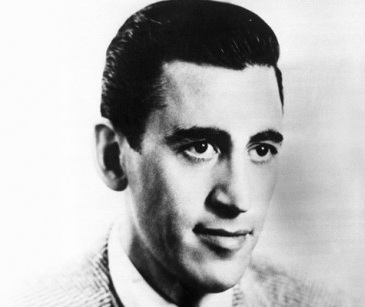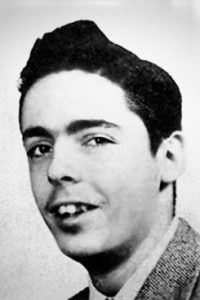by Dan Geddes
It will probably be impossible for future generations to understand the special place that J.D. Salinger held in the minds of readers in the mid-to-late twentieth century.
The Catcher in the Rye remains a classic statement of youth alienation, and continues to attract defenders and detractors. Many of its young readers are grateful to find a book that not only understands them, but also articulates their misgivings about growing up and joining the compromised adult world, where there seems to be little room for ideals.
J.D. Salinger remained one of the great legends in American writing throughout his life even though he stopped publishing in 1965. He enjoyed an era of preeminent literary fame in the 1950s and 1960s, yet, in the spirit of Holden Caulfield or Buddy Glass, he himself dropped out of society, living a reclusive life in Cornish, New Hampshire. Salinger’s “reclusiveness,” however, only reinforced his fame. Here was a writer who practiced what he preached. The implication was that Salinger found society—at least New York literary society—too phony. He retained a strong readership, and even gained new fans, many of whom discovered his books from school reading lists.
For Baby Boomers, Holden Caulfield represented an important milestone on the way to Sixties culture. When Franny and Zooey (1961) came out in book form (both stories were published earlier in The New Yorker magazine), it rekindled interest in Salinger’s novel. So, the early 1960s were probably the peak of his fame. Whenever he published it was an “event,” and no one knew yet that he would soon stop publishing for good. Since “Hapworth” (1965) Salinger has given very few interviews. He emerged from his lair a few times to sue people, most famously Ian Hamilton, a biographer who intended to use excerpts from Salinger’s unpublished letters. Salinger sued, the case went to the Supreme Court, and Hamilton was forced to paraphrase most passages from the letters.[1] In 2009, Salinger sued to stop the US publication of 60 Years Later: Coming Through the Rye, which was presented as a sequel to The Cather in the Rye, but was probably more like fan fiction. However, many people began to think that Salinger’s attempts to keep his privacy only drew attention to himself.
Salinger instilled a rare sense of devotion in many readers. The Catcher in the Rye still serves as a sacred text and touchstone for many readers, at least temporarily in their youth. Franny and Zooey presented a college-level update to The Catcher in the Rye’s anti-social confession, along with a spiritual sensibility. Zooey provided a spiritual and theological foundation, an Eastern critique of the self of which Holden Caulfield was incapable. Since the Glass children are all geniuses, their ruminations are supposed to carry more intellectual water than Holden’s. Zooey shows intellectual pretension beyond anything in Catcher. And this is just a foretaste. By the time we get to Seymour: An Introduction and finally Hapworth 16, 1924, Salinger’s Glass Family can beat the dreadful academics at their own game—Seymour garners a Columbia PhD at 21, and becomes a professor— and also critique their soullessness as denizens of “neo-Freudian” schools. By Hapworth, Salinger’s last story, young Seymour and Buddy are at summer camp, writing home to request their parents to send them an entire library of world literature in original languages—just to get them through the summer. Salinger’s heroes are brighter and more soulful than ordinary academics, who are often objects of ridicule in stories like “Teddy” (which is not technically a Glass family story, but it is in spirit) “Franny,” “Zooey” and “Seymour: An Introduction.”
Salinger created comfortable zones for youth alienation. Youth in turn felt like Salinger understood them, and they venerated him with cult-like reverence. Perhaps almost no other twentieth century American writer had such a devoted readership. Thomas Pynchon’s readers are also described as cult-like followers, but Pynchon’s readers are far fewer than Salinger’s, and Pynchon does not project himself into his texts so blatantly. (Pynchon’s works are also more forgiving of ordinary (non-literary) people, and so don’t foster the same exclusive mentality as Salinger’s). The devotion of Salinger’s fans could be extreme, as seen in Mark David Chapman’s obsession with Catcher prior to his shooting John Lennon dead in 1980. Catcher’s reputation for attracting nutty devotion was acknowledged in Conspiracy Theory (1997), in which Mel Gibson’s paranoid-conspiracy-theorist character obsessively keeps many copies of Catcher.
Because his characters sharply criticize modern society, Salinger’s books encourage readers to examine their core beliefs. What does it mean to be genuine (or “phony”)? What does it mean to be selfish? Is it desirable to succeed, or does it inevitably corrupt? Both Holden Caulfield and Franny Glass express the desire to quit adult life before it has even begun. Zooey provides an example of how to live in society (he is an actor in a TV soap opera, and so hardly lives a retiring life) despite his genius and spirituality, but he has not forgotten the lessons of his lifelong meditations. Seymour and Buddy also provide role models and guidance, Seymour enjoying an almost saintly status, despite his inexplicably committing suicide.
The overall impression one gets of Salinger’s most cherished characters is that of arrested development. Holden cannot adapt, and ends up institutionalized (at least temporarily). Seymour actually kills himself at the age of 31 in the shocker ending for the first story he appears in, “A Perfect Day for Bananafish.” Holden once enjoyed enormous credibility with young readers, because he swears like a sailor, and school teachers often explained that the book had been banned many times (which is usually the best publicity a book can receive).
Despite it all, Holden Caulfield may be losing his grip on younger readers. His profanities are no longer as shocking to most students. More than anything, his slangy language has become somewhat dated. He doesn’t carry a cell phone. Some readers conclude that he’s just gay after all (perhaps Mr. Antolini had triggered Holden’s homosexual panic), but that he couldn’t come out as a teenager in 1951. So in some ways, Catcher seems more interesting from a historical perspective. Holden’s sarcasm and irony are now such a mainstream part of American culture (with people imitating the deadpan cynicism in TV sitcoms and movies) that Holden’s attitudes may seem normal to some readers.
Also the space that Salinger carved out has been filled in with other important books over the decades. There have been countless first novels written under the influence of Catcher. John Irving (who in Piggy Sneed wrote that he found Catcher “as perfunctory as masturbation”) has managed to create a magic somewhat similar to the Glass stories by writing about his affluent families with great humor, while also producing gripping, novel-length stories (however sensationalist). In Irving’s books, however, there is enough rape, murder, and dismemberment to attract a more action-hungry readership. The movies of Wes Anderson, especially Rushmore and The Royal Tenenbaums, feel like Salinger books. The Royal Tenenbaums could just as well be the Glass family (or the Berry’s from Irving’s Hotel New Hampshire). In Rushmore, although Max Fischer (like Holden) is manager of the fencing team and flunks out of prep school, Max is the anti-Holden, writing plays, embracing life, and shaping his own sense of reality. He is a much better role model than Holden Caulfield.
#
Salinger’s literary output is amazingly small considering his reputation—basically four small books. His early stories have never been published as a book. So his reputation rests on these four books: The Catcher in the Rye, Nine Stories, Franny and Zooey, and Raise High the Roofbeam, Carpenters and Seymour: An Introduction.
The Catcher in the Rye was the only novel he published. It is easily one of the most-read and influential American novels of the twentieth century. It is unclear how it will stand the test of time, but Catcher is clearly the cornerstone of Salinger’s reputation.
I re-read The Catcher in the Rye recently and was struck again by Holden’s voice. It is clear and genuine. We feel that this must be the voice of the adolescent Salinger, captured for all time in a text. Holden addresses you, the reader, directly. He is smart, perceptive, funny, verbally agile, and sensitive. Yet he is also an unsympathetic character in many ways. He is an elitist, a liar, a quitter. He is ungrateful for the life he has. He has many toxic emotions. Yet Holden’s negative traits give him even more credibility. He is a multi-faceted character. More than of almost any other literary character, people speak of Holden as if he were a real person. Salinger’s careful crafting of Holden’s voice was his greatest achievement.
Re-reading Catcher, Holden’s dark edge was still there: his smashing of all the windows in the garage when his brother Allie died shows he has some issues, but it seems tolerable as an expression of grief. His provoking the fight with Stradlater is typical. Holden may think he is defending Jane Gallagher’s honor (the girl who in checkers kept all her kings in the back row), but what other emotions are behind the Stradlater encounter? Holden verbally provokes Maurice as well. He tells how he doesn’t like fights though, and that the worst part of it is seeing the other guy’s face. Holden admits that would rather push them out the window or chop their head off with an axe. Holden describes his red hunting cap as a “people shooting hat. I shoot people in this hat.” This is disturbing to read, and alongside the devotion of a few lone nut assassins to Catcher, makes the book still feel dangerous. Will Smith’s monologue in John Guare’s Six Degrees of Separation on Holden’s violent tendencies rings true. Holden’s confession is disturbing.
Yet Holden remains trapped like a fly under glass. We get only his confession. Six months have elapsed between Holden’s two days in New York and his confession in the California rest home. Has he changed at all? We don’t know. There is no development. As such, Catcher is more of a literary text than it is a novel. I wish it were Part I of something larger. We never see him grow up, or see whether, as Mr. Antolini fears, that at age thirty Holden may turn out to be someone who will hate people on sight if they looked like they played football in college. If Salinger’s treasure chest full of unpublished novels includes one about Holden at a later phase of his life, I would like to read that, and only hope that it contains the same authenticity as Catcher.
Nine Stories is a classic set of short stories, the tightest work he ever produced (thanks in part to the editors at The New Yorker). These stories have the Salinger touch, especially the pitch-perfect dialogue. “A Perfect Day for Bananafish” introduces us to Seymour Glass, who later becomes perhaps the central character of his later work. Seymour, like Holden, has violent tendencies, and also is very sensitive. “Teddy” foreshadows the later Glass family seers, their indifference to their own physical bodies, and their derision toward professional academics. The shocking endings of “Bananafish” and “Teddy” are just endings rather than the culmination of development within the stories. Both are inexplicable and don’t really develop the main characters (quite the opposite, in a way!). Salinger felt most at home in the story form, where he could often show a slice of life (and death), rather than develop a traditional story. The Nine Stories, many of which were published before Catcher became a phenomenon, have a terse elliptical quality where every word counts. After Salinger becomes a literary celebrity, his stories contain more remarks and authorial intrusions. Perhaps his editors lacked the confidence to override Salinger’s opinion of what constituted compelling fiction.
The stories “Franny” and “Zooey” were first published in The New Yorker, and later published in book form as Franny and Zooey, which serves as volume one of the Glass family stories. (At least two of the Nine Stories also portray Glass children, though not yet in the later style). Salinger draws an endearing portrait of Franny. Many readers identify with her in a way similar to their identification with Holden, but Franny is intended for a college-age audience. Franny expresses some of same criticisms of society as Holden, but she is looking for a spiritual solution rather than just complaining about it.
“Zooey” is probably the high watermark of the Glass family saga. The title character encourages his sister to live life in the real world no matter how phony she finds it. He points out how judgmental she is, and that this attitude toward the world is not good for her own soul. But “Zooey” contains almost no action. The story lavishes pages on Zooey sitting in the bathtub reading a letter from Buddy, and then actually haranguing his mother in a mean-spirited way (not what we expect from someone so sage). There are only two scenes, consisting almost entirely of dialogue about Franny’s spiritual crisis. The story does come to a close of sorts, with Franny apparently fortified to carry on in the superficial world by the notion that the preterite, the non-Glasses of the world, are like Seymour’s Fat Lady, who is also somehow the same as Jesus Christ. Yes, we are all one (somehow).
“Raise High the Roofbeam, Carpenters” and “Seymour: An Introduction” comprise the second volume of Glass family stories, and are undoubtedly the weakest of the four books. “Raise High” depicts Seymour’s wedding day told from the perspective of Buddy; Seymour never makes an appearance, neither at the wedding nor in the story. From Buddy’s perspective this is more or less justified because Seymour is a sensitive poet-saint. “Raise High” is funny, especially at the Matron of Honor’s expense (she is “normal” and cannot understand Seymour’s artist-saint ways). But it is curiously uneventful, and does little to further Seymour’s characterization. The reader gets a last look at how the non-Glass world perceives someone as special as Seymour.
In “Seymour: An Introduction” Buddy’s canonization of Seymour continues. Buddy ruminates about Seymour in a formless, self-conscious, and intrusive authorial style. Buddy is still battling with his dead brother for the reader’s affection. His main point is that the flesh-and-blood Seymour simply cannot be captured in words. However true this is, pointing out the limitations of language to capture characters is an appealing, if strange, stance for even a self-deprecating novelist like Buddy or Salinger to take. Perhaps it is a cop-out. Perhaps it would help if he (Buddy or Salinger) would actually show Seymour in scenes. We see Seymour in real time only in “Bananafish.” It is almost as if Seymour is God and we are not allowed to gaze upon his face. “Seymour” reads like an active attempt by the author to distance his readers from his precious characters. It goes on in a manner so precious that only the faithful can read on. As self-indulgent as it is, “Seymour” could have served as an appropriate coda to the Glass family saga. The reader has a sense that after this last jab at his overzealous readership that Salinger is fading into oblivion, and perhaps has said good-bye (at least to the Glass family).
Thus the publication of “Hapworth 16, 1924,” the last of Salinger’s published stories, must have come as a surprise. It appeared in The New Yorker in 1965, but never in book form. It was announced that it would appear as a book in 1996, but it still has not appeared despite occasional rumors. “Hapworth” has few admirers. Nearly the entire 25,000 word story is in the form of a letter from seven year old Seymour Glass to his parents from summer camp. It displays astonishing erudition and sophistication. Here we hear the child in his own precious voice, but it doesn’t read like a serious story. It reads like a display of authorial erudition placed in the mouth of a seven-year old character. Perhaps only such an epistolary story as this could have been more off-putting to readers hungry for actual fiction with action, conflict, or scenes than “Seymour: An Introduction”.
Perhaps by killing off Seymour Glass so early, Salinger wrote himself into a trap from which he could never escape. Seymour Glass is his greatest seer, yet he commits suicide. Is this the path of wisdom? In any case, Seymour remains completely obfuscated in mystery, just as his author seemed to wish.
#
Despite the halo of authenticity that surrounds some of his characters, Salinger’s greatest gift was always comedic. Holden is a hilarious social critic, as are Franny and Zooey and Buddy. Reading about them we feel we are on the inside of a cherished family circle. Here we are safe and the phony outside world doesn’t intrude. Here we are smarter, more sophisticated, and more spiritual than that horrible outside world. Holden and the Glass family share a 1950’s Manhattan sophistication and affluence; reading about their lives serves as an escape from one’s own workaday, mundane life.
Various reports from the Salinger compound suggest that he wrote regularly every day since the 1960s but has chosen not to publish. Did Salinger ever manage to confront what his Glass family stories were really about? Do his characters ever learn to engage the world, or do they withdraw, as their creator did? Salinger’s characters sought escape from the artificiality of modern life (with only Zooey really coming to terms with co-existing with other people). Salinger himself acquired the means to escape from society, and to choose unilaterally the terms on which he interacted with other people. Many people do not have that choice, and their struggles to earn a living in a corrupt society, while retaining their dignity, have served as subject matter for social novels. Salinger did depict real world people in Catcher and Nine Stories. The longer Glass family stories are mainly pure escapism from that world, and thus are a guilty pleasure.
Salinger’s best writing conveys an unusual clarity found in the work of few other writers. Achieving such lucidity was probably laborious and might explain his having written mostly short stories rather than novels (and having spent reportedly ten years writing The Catcher in the Rye). His style is so singular and had such an enormous influence that he will probably always be read. Now that he has died, some readers eagerly await the unlocking of his vault of unpublished fiction. However, I fear that the result may be an experience as disappointing as going to the library to find “Hapworth” on microfiche. We shall see.
4 April 2010
See also: Book reviews and criticism









Be First to Comment